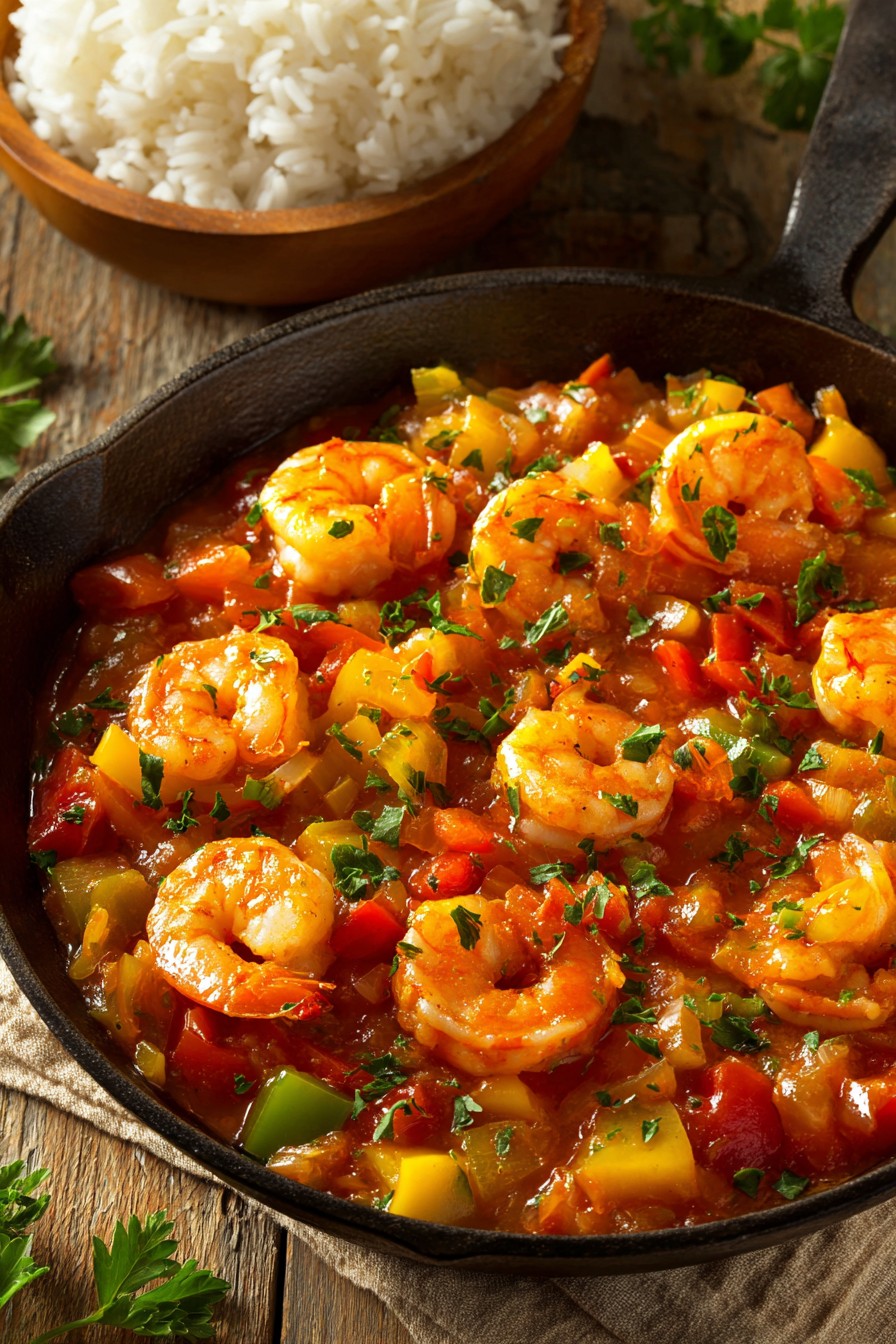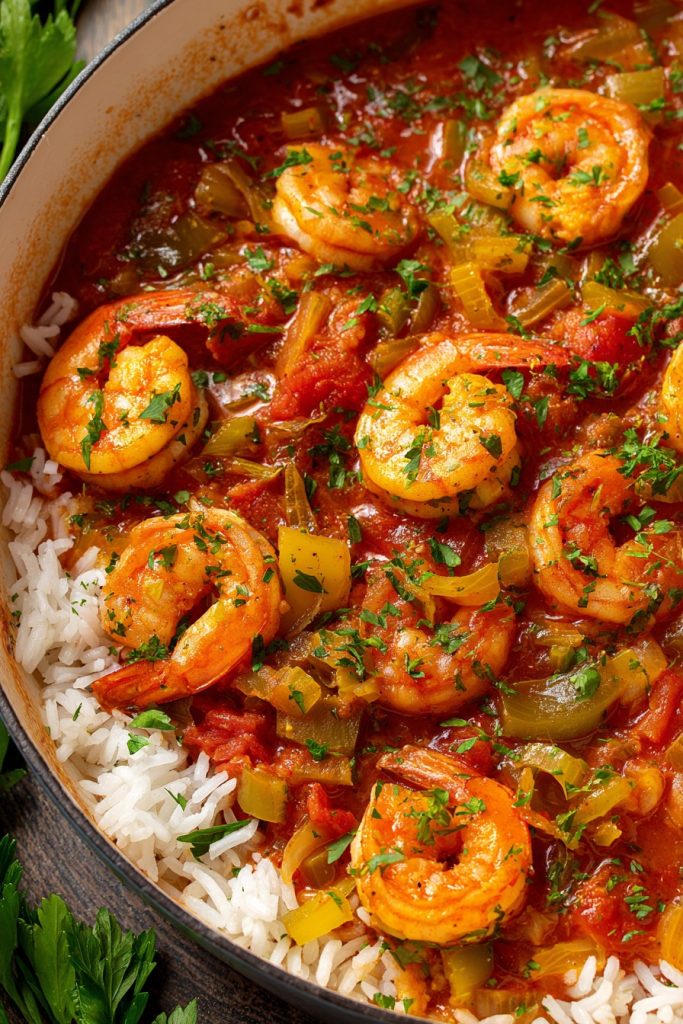Tantalizing, spicy, and utterly irresistible—this Creole shrimp recipe captures the vibrant soul of Louisiana cooking in one spectacular dish. The moment these plump shrimp hit your tongue, you’ll be transported straight to the French Quarter with layers of complex spices, rich tomato depth, and that signature Creole heat that builds with every glorious bite. This isn’t just dinner—it’s an experience that will awaken every single taste bud and leave you craving more.
Why This Recipe Works
- The holy trinity of onions, bell peppers, and celery forms the foundational flavor base that creates authentic Creole depth and complexity that permeates every single component of the dish
- Toasting the spices in hot oil before adding liquids unlocks their essential oils and intensifies their aromatic qualities, creating a flavor profile that’s both bold and beautifully balanced
- Using both tomato paste and crushed tomatoes provides dual layers of tomato flavor—concentrated depth from the paste and bright acidity from the crushed tomatoes that cut through the richness
- Simmering the sauce for exactly 25 minutes allows the flavors to meld perfectly while maintaining the shrimp’s tender texture when added during the final cooking phase
- The combination of fresh herbs added at the end preserves their vibrant, bright notes that contrast beautifully with the deep, developed flavors of the simmered sauce
Ingredients
- 2 pounds large raw shrimp, peeled and deveined with tails intact
- 3 tablespoons olive oil, divided for different cooking stages
- 1 large yellow onion, finely diced to release maximum flavor
- 1 green bell pepper, seeds removed and finely chopped
- 2 celery stalks, finely chopped for texture and flavor
- 4 garlic cloves, minced until fragrant and pungent
- 2 tablespoons tomato paste, concentrated for deep flavor
- 1 can (14.5 ounces) crushed tomatoes, providing rich acidity
- 1 cup chicken broth, preferably low-sodium for control
- 2 teaspoons smoked paprika, for that essential smoky depth
- 1 teaspoon dried oregano, crushed between fingers to release oils
- 1 teaspoon dried thyme, for earthy herbal notes
- 1/2 teaspoon cayenne pepper, adjustable for heat preference
- 1/2 teaspoon black pepper, freshly ground for maximum aroma
- 1 teaspoon salt, or to taste for perfect seasoning balance
- 2 bay leaves, whole for subtle background flavor
- 1/4 cup fresh parsley, chopped for bright finishing notes
- 2 tablespoons fresh lemon juice, squeezed just before serving
- Cooked white rice, for serving to soak up the glorious sauce
Equipment Needed
- Large heavy-bottomed skillet or Dutch oven
- Sharp chef’s knife
- Cutting board
- Measuring spoons and cups
- Wooden spoon or spatula
- Mixing bowls
- Garlic press or mincer
- Citrus juicer
Instructions

Prepare the Holy Trinity Foundation
Heat 2 tablespoons of olive oil in your large heavy-bottomed skillet over medium-high heat until it shimmers and dances across the surface, about 90 seconds. Add the finely diced yellow onion, chopped green bell pepper, and celery all at once—listen for that satisfying sizzle as they hit the hot oil. Cook these aromatic vegetables, stirring frequently with your wooden spoon, for 6-8 minutes until the onions turn translucent with golden edges and the peppers soften while still maintaining a slight crunch. The celery should become tender but not mushy, releasing its subtle herbal fragrance that mingles beautifully with the sweet onion and bright pepper notes. This holy trinity forms the very soul of Creole cooking, so take your time here—the depth of flavor you develop now will carry through the entire dish. Watch for the moment when the vegetables release their natural sugars and begin to caramelize slightly around the edges, creating those delicious browned bits that will deglaze into incredible flavor later.
Build the Spice Foundation
Push the cooked vegetables to the perimeter of your skillet, creating a clear hot spot in the center. Add the remaining tablespoon of olive oil to this space and let it heat for 30 seconds until it shimmers. Now add your minced garlic and cook for exactly 60 seconds—just until fragrant but not browned, as burnt garlic turns bitter and ruins the delicate balance. Immediately add the tomato paste directly to the hot spot and cook, stirring constantly, for 2 full minutes until it darkens from bright red to a deep brick color and develops a rich, almost nutty aroma. This crucial step transforms the tomato paste from raw and sharp to complex and deeply flavorful. Now sprinkle in all your dried spices—the smoked paprika, dried oregano, dried thyme, cayenne pepper, and black pepper—right into the hot tomato paste mixture. Toast these spices for 45 seconds, stirring continuously, until they become incredibly fragrant and release their essential oils. The air should fill with the intoxicating scent of blooming spices, a signature of authentic Creole cooking technique.
Create the Signature Sauce
Pour the crushed tomatoes and chicken broth into the skillet, using your wooden spoon to scrape up all those delicious browned bits from the bottom—this is where incredible flavor lives! Add the bay leaves and salt, then bring the mixture to a vigorous boil where large bubbles break across the entire surface. Once boiling, immediately reduce the heat to maintain a gentle simmer where small bubbles lazily break the surface around the edges. Cover the skillet partially, leaving about a 1-inch gap for steam to escape, and let the sauce simmer undisturbed for exactly 25 minutes. During this time, the flavors will meld and deepen, the tomatoes will break down further, and the liquid will reduce by about one-third, creating a sauce that’s thick enough to coat the back of a spoon. Resist the temptation to stir too frequently—this slow, gentle cooking allows the flavors to develop complexity without becoming muddy or overcooked.
Cook the Shrimp to Perfection
After 25 minutes of simmering, your sauce should be richly colored and beautifully thickened. Now add the raw shrimp in a single layer, nestling them into the hot sauce without overcrowding. Cook for 3-4 minutes, turning each shrimp once halfway through, until they transform from gray and translucent to opaque and pink with a slight curl. The shrimp are perfectly cooked when they reach an internal temperature of 120°F and feel firm yet springy to the touch—overcooking will make them rubbery and tough. As the shrimp cook, they’ll release their sweet, briny juices into the sauce, creating an incredible seafood-infused flavor base. Watch carefully during these final minutes—the difference between perfectly cooked and overcooked shrimp is literally 60 seconds. When done, immediately remove the skillet from heat to prevent residual cooking from toughening your beautiful shrimp.
Finish with Bright Fresh Notes
Remove the bay leaves from the finished dish—their job is done, and leaving them in can impart bitterness. Now stir in the freshly chopped parsley and squeeze the lemon juice directly over the shrimp and sauce. The lemon juice will brighten all the flavors, cutting through the richness while enhancing the shrimp’s natural sweetness. Let the dish rest for 2 minutes off heat to allow the fresh herbs and citrus to meld with the warm sauce. Serve immediately over hot cooked white rice that will soak up every drop of the incredible sauce. The contrast between the bright, fresh finish and the deep, developed sauce creates that signature Creole complexity that makes this dish truly unforgettable. Each component should be distinct yet harmonious—the tender shrimp, the rich sauce, the fluffy rice, and that final burst of herbal freshness.
Tips and Tricks
For shrimp that maintain perfect texture every single time, pat them completely dry with paper towels before cooking—this ensures they sear rather than steam when they hit the hot sauce. If you have access to wild-caught Gulf shrimp, they’ll provide superior flavor with their natural briny sweetness that farm-raised varieties simply can’t match. When selecting shrimp, look for those labeled “16-20 count per pound”—this size provides the ideal balance between substantial bite and quick cooking time. For maximum flavor development, consider making the sauce base up to two days in advance and refrigerating it, then simply reheating and adding the shrimp when ready to serve—the extended resting time allows the flavors to marry even more completely. If your sauce seems too thin after the initial simmering period, remove the lid completely and let it bubble gently for an additional 5-7 minutes until it reaches your desired consistency. Conversely, if it becomes too thick, add chicken broth one tablespoon at a time until it loosens to your preference. For those who love extra heat, serve with Louisiana-style hot sauce on the side rather than increasing the cayenne in the recipe—this allows each diner to customize their spice level without compromising the dish’s balanced flavor profile. When storing leftovers, remove the shrimp from the sauce and store separately to prevent them from becoming tough and overcooked when reheated. For freezing, the sauce base freezes beautifully for up to three months, but always add fresh shrimp when reheating for the best texture. If you’re serving a crowd, you can double the recipe successfully, but use two large skillets rather than one enormous pot to ensure even cooking and proper reduction of the sauce. Finally, for restaurant-quality presentation, garnish with additional fresh parsley and lemon wedges, and serve in shallow bowls that showcase the beautiful color contrast between the vibrant red sauce, pink shrimp, and white rice.
Recipe Variations
- For a heartier Creole shrimp and sausage version, add 8 ounces of sliced andouille sausage when cooking the holy trinity—the smoked sausage will infuse the entire dish with incredible smoky depth and additional protein that makes it a complete one-pot meal. Brown the sausage slices first until crispy around the edges, then remove them and proceed with the vegetables, adding the sausage back when you add the liquids.
- Transform this into spectacular Creole shrimp étouffée by increasing the holy trinity vegetables by 50%, using a traditional roux made from 3 tablespoons each of flour and butter cooked until peanut butter-colored, and simmering for 45 minutes total to develop the characteristic thick, gravy-like consistency that defines classic étouffée.
- Create a stunning Creole shrimp pasta by tossing the finished dish with 12 ounces of cooked linguine or fettuccine, adding 1/2 cup of heavy cream during the final minutes of cooking for richness, and topping with freshly grated Parmesan cheese and chopped scallions for an Italian-Creole fusion that’s absolutely irresistible.
- For a lighter Creole shrimp stew, increase the chicken broth to 2 cups, add 1 cup of sliced okra during the last 10 minutes of simmering, and serve in deep bowls with crusty French bread for dipping—the okra provides authentic Southern texture while helping to naturally thicken the broth.
- Make impressive Creole shrimp stuffed peppers by hollowing out 4 large bell peppers, filling them with the finished shrimp mixture mixed with 1 cup of cooked rice, topping with shredded Monterey Jack cheese, and baking at 375°F for 20 minutes until the peppers are tender and the cheese is golden and bubbly.
Frequently Asked Questions
Can I use frozen shrimp for this Creole shrimp recipe?
Absolutely, frozen shrimp work beautifully in this recipe provided you thaw them properly. The key is gradual thawing—place the frozen shrimp in a colander and run cold water over them for 10-15 minutes until completely thawed, then pat them thoroughly dry with paper towels before cooking. Never thaw shrimp at room temperature or in warm water, as this can create texture issues and food safety concerns. High-quality frozen shrimp are often flash-frozen shortly after harvesting, which actually preserves their freshness better than “fresh” shrimp that may have been sitting on ice for days. Look for frozen shrimp without added sodium solutions or preservatives for the best flavor and texture. Once thawed, treat them exactly as you would fresh shrimp, and they’ll absorb the Creole spices and sauce flavors perfectly while maintaining that desirable firm-yet-tender bite.
What’s the difference between Creole and Cajun seasoning for shrimp?
While both Creole and Cajun cuisines originate from Louisiana, their seasoning profiles reflect different cultural influences and approaches. Creole seasoning typically includes paprika, garlic powder, onion powder, black pepper, white pepper, cayenne, oregano, thyme, and sometimes basil—creating a more complex, herbal-forward blend with European influences. Cajun seasoning tends to be simpler and spicier, focusing on cayenne, garlic, onion, and black pepper with less herbal complexity. The most significant difference lies in the cooking style: Creole dishes often feature tomatoes and are more sauce-based, reflecting urban French and Spanish influences, while Cajun cooking typically avoids tomatoes and uses drier cooking methods rooted in rural French Acadian traditions. For this recipe, the individual spices create an authentic Creole profile that complements the tomato-based sauce perfectly.
How can I adjust the spice level to suit different preferences?
Controlling the heat in Creole shrimp is easily customizable without compromising flavor. Start by reducing the cayenne pepper to 1/4 teaspoon for mild heat, or omit it entirely for those sensitive to spice. The smoked paprika provides warmth without intense heat, so keep that measurement consistent. For medium heat, maintain the original cayenne amount but remove the seeds from fresh chili peppers if adding any. For extra fiery versions, increase cayenne to 1 teaspoon or add 1/2 teaspoon of crushed red pepper flakes when toasting the spices. The most effective approach is serving Louisiana-style hot sauce on the side—this allows each person to customize their portion. Remember that the holy trinity vegetables, tomatoes, and shrimp naturally provide sweetness that balances heat, so adjustments should be gradual. Taste the sauce before adding shrimp and adjust seasoning then.
What’s the best way to serve Creole shrimp for maximum impact?
Presentation transforms this dish from simple dinner to spectacular experience. Serve in wide, shallow bowls that showcase the vibrant red sauce against white rice, with the pink shrimp arranged artfully on top. Garnish with additional chopped fresh parsley and lemon wedges for color contrast. For traditional New Orleans style, accompany with crusty French bread for sopping up every last drop of sauce—the crisp exterior and soft interior provide perfect textural contrast. A simple green salad with tangy vinaigrette cleanses the palate between rich, spicy bites. For beverage pairings, a crisp lager or pale ale cuts through the richness, while a slightly sweet Riesling or sparkling wine balances the heat. If serving family-style, present the shrimp in the cooking skillet for rustic appeal, with rice and accompaniments in separate serving dishes for customizable portions.
Can I make this Creole shrimp recipe ahead of time?
This dish offers excellent make-ahead flexibility with proper technique. The sauce base can be prepared completely up to 3 days in advance—after simmering for 25 minutes, cool it rapidly by transferring to a shallow container and refrigerating. The flavors actually improve with time as they meld together. When ready to serve, reheat the sauce gently on the stove, then add raw shrimp and cook as directed. For partial preparation, you can chop all vegetables and measure spices a day ahead, storing them separately in airtight containers. However, cook the shrimp only when ready to serve, as reheating previously cooked shrimp typically results in rubbery texture. If you must make the complete dish ahead, slightly undercook the shrimp by 30 seconds, then cool quickly and refrigerate separately from the sauce. Reheat gently just until warmed through.
Summary
This spectacular Creole shrimp delivers authentic Louisiana flavor with perfectly cooked shrimp in a rich, spicy tomato sauce. The holy trinity foundation, toasted spices, and bright finishing touches create incredible depth and complexity that will transport your taste buds straight to New Orleans. Serve over fluffy rice for the ultimate comfort food experience that’s both impressive and approachable.
Creole Shrimp
5
servings15
minutes45
minutesIngredients
Instructions
- 1 Heat 2 tablespoons olive oil in large skillet over medium-high heat. Add onion, bell pepper, and celery. Cook 6-8 minutes until softened.
- 2 Push vegetables to sides, add remaining oil. Add garlic and cook 1 minute. Add tomato paste and cook 2 minutes until darkened.
- 3 Add spices and toast 45 seconds. Pour in crushed tomatoes and broth, add bay leaves and salt. Bring to boil, then simmer 25 minutes.
- 4 Add shrimp in single layer. Cook 3-4 minutes, turning once, until pink and opaque.
- 5 Remove bay leaves. Stir in parsley and lemon juice. Serve immediately over rice.



